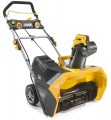Battery voltage
Nominal voltage of the battery used in the unit with the corresponding engine type (see above). Theoretically, a higher voltage allows you to achieve more power, but in fact there is no direct relationship between these points. In addition, manufacturers choose batteries to deliver the intended power, rotational speed, and other performance. Therefore, in the selection and normal use of the unit, this parameter has a secondary, reference value; it may be needed mainly for some specific tasks, for example, searching for a spare battery or a “non-native” charger, or comparing different batteries by capacity (see below).
Capacity
The capacity of the battery used in the electrical unit with the appropriate power supply (see "Engine type").
Theoretically, a higher capacity allows you to work longer on a single charge, but in fact, not everything is so simple. Firstly, battery life will also depend on the characteristics of the unit itself, primarily on the working (and, accordingly, consumed) engine power. Secondly, the actual amount of energy stored by the battery is determined not only by the number of amp-hours, but also by the operating voltage in volts. In other words, two batteries with the same Ah but different operating voltages will have different actual capacities. In fact, all this means that only snow blowers with similar engine power and the same battery voltage can be compared in terms of capacity, and then very approximately. It is best to evaluate battery life according to the operating time directly stated in the characteristics.
Compatible batteries
The name of the battery that is compatible with the device. It helps to buy a spare or find a suitable one in case of a breakdown of the main one.
Wheels diameter
Snow blower wheel diameter. Permeability primarily depends on this parameter: the larger the diameter of the wheels, the easier they will overcome obstacles in the form of curbs, stones, bumps, etc. This is especially important for self-propelled models (see "Design"); on the other hand, larger wheels require a more powerful engine. Therefore, if the unit is to be used on more or less flat terrain, it makes sense to choose a model with smaller wheels.
The smallest diameter found in modern snow blowers is about 12 – 13 cm; in the largest and heaviest models, it can reach 50 cm.
Noise level
The average noise level produced by the snow blower during operation; the actual volume may differ slightly from this figure, but these deviations are usually negligible.
Note that snow blowers are quite loud equipment, plus the higher the power, the generally higher the noise level. This parameter is measured in decibels, this is a non-linear value, so the actual loudness is easiest to evaluate using comparative tables. So, the most "quiet" modern models give out about 55 – 60 dB — this can be compared with a conversation in slightly raised tones. 70 dB corresponds to a loud conversation, 80 dB to noise on a busy city street, 90 dB to a freight car at a distance of about 7 m, 100 dB to an industrial workshop, 110 dB to a tractor motor at a distance of 1 m.
The lower the noise level, the more comfortable this model will be to use. And according to sanitary standards, the maximum noise level considered safe for prolonged exposure (up to 8 hours) is 80 dB. So if the selected unit is noisier, and you plan to work often and for a long time, you should take care of protective headphones or earplugs.

